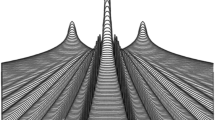Abstract
Nearly linear current-voltage curves are frequently found in biological ion channels. Using the drift limit of the substantially non-linear Poisson-Nernst-Planck equations, we explain such behavior of diffusion-controlled charge transport systems. Starting from Gauss' law, drift, and continuity equations we derive a simple analytical current-voltage relation, which accounts for this deviation from linearity. As shown previously, the drift limit of the Nernst-Planck equation applies if the total electric current is dominated by the electric field, and integral contributions from concentration gradients are small. The simple analytical form of the drift current-voltage relations makes it an ideal tool to analyze experiment current-voltage curves. We also solved the complete Poisson-Nernst-Planck equations numerically, and determined current-voltage curves over a wide range of voltages, concentrations, and Debye lengths. The simulation fully supports the analytical estimate that the current-voltage curves of simple charge transport systems are dominated by the drift mechanism. Even those relations containing the most extensive approximations remained qualitatively within the correct order of magnitude.
Similar content being viewed by others
Author information
Authors and Affiliations
Additional information
Received: 24 September 1998 / Revised version: 22 January 1999 / Accepted: 22 January 1999
Rights and permissions
About this article
Cite this article
Syganow, A., von Kitzing, E. The drift approximation solves the Poisson, Nernst-Planck, and continuum equations in the limit of large external voltages. Eur Biophys J 28, 393–414 (1999). https://doi.org/10.1007/s002490050223
Issue Date:
DOI: https://doi.org/10.1007/s002490050223




